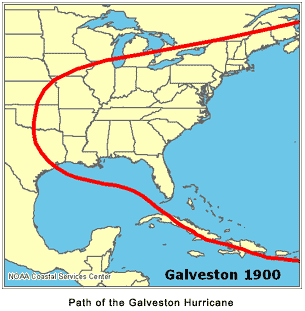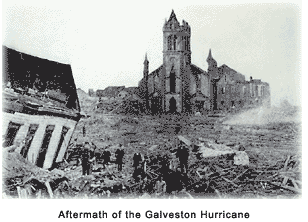Hurricanes were once unnamed and data about them were lumped together under "Storms," tucked away in dank, dusty, dimly lit library stacks. Nevertheless, one tempest stands out as the nation`s deadliest.
More financially costly and life-disruptive storms have occurred, but the hurricane that swept through Galveston, Texas, like Sherman through Atlanta, killed between 6,000 and 8,000 people, making it the deadliest "tropical cyclone" in United States history.
Galveston, Texas, 1900
Galveston Island lies off the southeastern Texas coast, situated parallel to the mainland, creating a buffer between the Gulf of Mexico and Galveston Bay. With Houston located on the 600 square-mile bay`s western flank, Galveston, the "Gateway to the Bay," became a major player in the late-1800s shipping trade. More than 70 percent of the nation`s cotton crop passed through the port of about 40,000 residents. One thousand ships docked in Galveston at various times throughout the year.
Wealthy visitors traveled to Galveston for a relaxing and therapeutic dip in the warm, shallow waters of the Gulf of Mexico, and by all accounts, its populace was second in the nation in per capita wealth. Life was good.
Galveston had weathered a large storm 25 years earlier. Surviving that event lent an air of smugness to residents` attitudes about any future fury Mother Nature might deal out. There had been talk of building a seawall after that storm, but the naysayers won out.
 September 8, 1900
With only rudimentary equipment available to the local National Weather Service meteorologist, Isaac Cline, forecasting was a matter of watching the horizon and the barometer to predict the whim of the elements. No early warning systems were in place at the time, although the NWS had received reports that a "tropical storm" had moved across Cuba four days before and was buffeting the Mississippi and Louisiana coastlines as late as September 7.
When his day began at 5 a.m., Cline noticed rising gulf water washing over the island`s lower elevations. When the barometer dropped and the wind grew stronger, and sea swells begin to rise, Cline left his post to urge people along the beach to go home. He also advised the residents within the first three blocks of the shore to move to higher ground.
His warnings were largely ignored. As the day passed, the storm strengthened. By midafternoon, the telegraph lines went down, which closed communication to the outside world.
Using today`s methods to determine storm strength by such calculable evidence as storm surge — 15 and a half feet in Galveston that night — meteorologists have concluded that winds reached between 130 and 140 miles per hour, a Category 4 hurricane (5 is strongest).
In pitch darkness, people fought for their lives. Houses crumbled around them. A two-story high wall of debris steamrollered the island. Eyewitness accounts reveal that there was no island left — just the occasional roof of a once-proud building clearing the waves. Twenty percent of the population were killed.
The aftermath
The destruction of Galveston`s bridges and railways, as well as its telegragh lines, had isolated the community from the world. The morning after revealed one of the few ships at the docks to survive the ordeal. The vessel headed to Houston to report that Galveston was in shambles and that rescue assistance was desperately needed.
September 8, 1900
With only rudimentary equipment available to the local National Weather Service meteorologist, Isaac Cline, forecasting was a matter of watching the horizon and the barometer to predict the whim of the elements. No early warning systems were in place at the time, although the NWS had received reports that a "tropical storm" had moved across Cuba four days before and was buffeting the Mississippi and Louisiana coastlines as late as September 7.
When his day began at 5 a.m., Cline noticed rising gulf water washing over the island`s lower elevations. When the barometer dropped and the wind grew stronger, and sea swells begin to rise, Cline left his post to urge people along the beach to go home. He also advised the residents within the first three blocks of the shore to move to higher ground.
His warnings were largely ignored. As the day passed, the storm strengthened. By midafternoon, the telegraph lines went down, which closed communication to the outside world.
Using today`s methods to determine storm strength by such calculable evidence as storm surge — 15 and a half feet in Galveston that night — meteorologists have concluded that winds reached between 130 and 140 miles per hour, a Category 4 hurricane (5 is strongest).
In pitch darkness, people fought for their lives. Houses crumbled around them. A two-story high wall of debris steamrollered the island. Eyewitness accounts reveal that there was no island left — just the occasional roof of a once-proud building clearing the waves. Twenty percent of the population were killed.
The aftermath
The destruction of Galveston`s bridges and railways, as well as its telegragh lines, had isolated the community from the world. The morning after revealed one of the few ships at the docks to survive the ordeal. The vessel headed to Houston to report that Galveston was in shambles and that rescue assistance was desperately needed.
 Rescuers from Houston and other cities around the bay were confronted with an overwhelming task. Besides the human toll, stench from rotting animals and fish soon reached suffocating levels. Burial at sea was attempted for human remains, but the corpses eventually washed ashore. The remaining solution was to build funeral pyres to burn the bodies wherever they were found. The pyres were said to have burned for weeks.
One staggering fact remains: More people were killed in that storm than the more than 300 hurricanes that have hammered the United States since.
Galveston today
Resiliency and resolve characterize the survivors of that terrible storm of 1900. City fathers took on a Herculean rebuilding effort by elevating the city, in some cases to 17 feet, by dredging sand and raising some 2,100 buildings, including St. Patrick`s Church.
Today, the refurbished Victorian-style homes are drawing cards for tourists, as are new hotels that have been built along that seawall. The shipping business returned for a time, but the dredging of the Houston Ship Canal in 1909 and 1914 bypassed Galveston, thereby ending that colorful era.
The city today accommodates at least 60,000 people (2000 census) and enjoys a lively tourist trade along the popular five-block strip paralleling Galveston Bay, called "The Strand."
Rescuers from Houston and other cities around the bay were confronted with an overwhelming task. Besides the human toll, stench from rotting animals and fish soon reached suffocating levels. Burial at sea was attempted for human remains, but the corpses eventually washed ashore. The remaining solution was to build funeral pyres to burn the bodies wherever they were found. The pyres were said to have burned for weeks.
One staggering fact remains: More people were killed in that storm than the more than 300 hurricanes that have hammered the United States since.
Galveston today
Resiliency and resolve characterize the survivors of that terrible storm of 1900. City fathers took on a Herculean rebuilding effort by elevating the city, in some cases to 17 feet, by dredging sand and raising some 2,100 buildings, including St. Patrick`s Church.
Today, the refurbished Victorian-style homes are drawing cards for tourists, as are new hotels that have been built along that seawall. The shipping business returned for a time, but the dredging of the Houston Ship Canal in 1909 and 1914 bypassed Galveston, thereby ending that colorful era.
The city today accommodates at least 60,000 people (2000 census) and enjoys a lively tourist trade along the popular five-block strip paralleling Galveston Bay, called "The Strand."